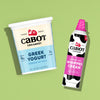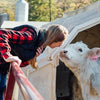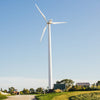
Sustainability in our Creameries
Our creameries are where the magic happens; the alchemy of turning fresh milk into award-winning dairy products.
The creameries are also home to a wide variety of sustainability initiatives, paying particular attention to energy, water and waste. Through collaboration with key partners like the Innovation Center for U.S. Dairy, initiatives with other companies and Green Team efforts at our own facilities, we are keeping busy trying to better manage our impacts. Learn more about Our Pledge to Sustainability now.

The more we work together, the better suited we are to reach our goals as stewards of the planet.
Sustainability on the Road
Our Transportation Fleet is Reducing its Greenhouse Gas Emissions

We are reducing our greenhouse gas emissions by using less fossil fuel, prioritizing driver and dispatcher training, and utilizing technological innovation. Our trucks are outfitted with energy efficient technology such as aerodynamic body modifications and low rolling resistance tires resulting in almost 20% more miles per gallon than the national average. Additionally, by equipping sleeper trucks with hybrid electric power units, our fleet reduced its idle time per truck by approximately 60%. All of these efforts combined contribute to saving nearly 60,000 gallons of fossil fuel and decreasing our annual greenhouse gas emissions by 5%.
Solar Power in our Plants
We Implemented our first Solar-Powered Waste Compactor at our Plant in Cabot, Vermont.

This initiative is a result of the long-time partnership between Cabot and Casella Waste Systems. Currently, the compactor is powered by a combination of traditional electricity and the solar energy absorbed from the newly installed panel. This solar attachment greatly reduces the amount of traditional electricity needed. On a typical sunny day, the solar panel can absorb enough energy to power the compactor for five days, instantly providing a source of renewable energy while also saving Cabot money on energy costs.
Water From Our Cows is Up-Cylced
Half of the Water Used at our Cabot Plant is Up-cycled from Milk

In 2014, we invested in a project that would save water, conserve resources & increase productivity.
This technology has transformed the way Cabot facilities handle wastewater. Because we know that we live in a world with limited resources, we are tackling the issue of conservation head on, using context based sustainability to make sure we only take our fair share to make the world’s best cheddar. Quick Facts on Cabot’s Water Re-use:
- Reduces ground water consumption
- Limits fuel and labor required for land spreading
- Requires a lower level of cleaning chemicals to be used on water
- Saves energy typically needed to heat water for cleaning purposes
- Reduces municipal potable water usage by 277,400 gallons annually
- Making Cheddar Better For Our Communities
Our Products
We aren’t fully satisfied by making the “World’s Best Cheddar” – we aspire to make our products even better by recognizing and managing the impacts they present. It begins by understanding those impacts over the life of the products – a life cycle assessment. On both the farm and facilities sides, we have been and still are very involved in national efforts to measure and manage the impacts of dairy agriculture.

We hope to better understand and learn more about the following:
- U.S. Dairy’s Environmental Footprint
- Life Cycle Assessment – Milk
- Life Cycle Assessment – Cheese
- Understand the Carbon Footprint of Cheese













